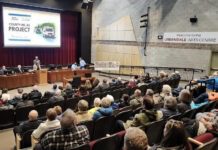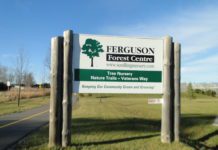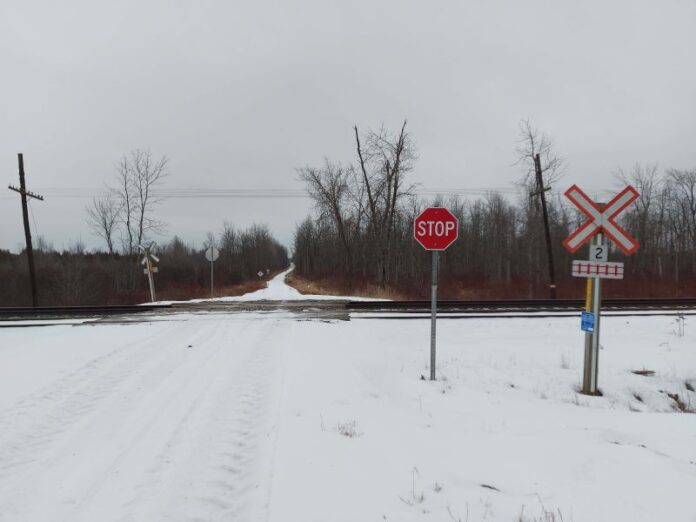by Brandon Mayor, Local Journalism Initiative Reporter
On January 11, Mayor Nancy Peckford posted a photo of a freight train, taken by local resident Craig Stevenson, on Kemptville’s community Facebook page. The Mayor used the photo to highlight the active state of rail lines in the Municipality, urging readers to “be vigilant at all rail crossings at all times.”
For many people, railways and railway crossings don’t warrant so much as a fleeting thought. We frequently pass by the raised crossing arms with no train in sight on our commutes, and may occasionally have to wait for a passing train for a few minutes before proceeding. The only railway company operating through North Grenville is Canadian Pacific Railway (CPR), whose so-called “Winchester subdivision” of their Toronto to Montreal branchline runs through east to west. The line runs south of the Kemptville town limits and just north of Oxford Mills, missing the populated areas in the Municipality.
The CPR recently upgraded the signaling and removed large sections of what used to be a double track line, turning the Winchester subdivision into a single track mainline with “siding” tracks, where trains can pull over to pass each other. For this reason, locals may notice more instances of trains temporarily blocking rail crossings in remaining double track sections while they wait for another train. Rail transportation is extremely safe and accidents, even at grade crossings, are rare. However, accidents at crossings have a high chance of turning deadly when they do occur, because of the sheer size and speed of trains, and their inability to stop quickly. A freight train travelling at the maximum allowable speed will often take a kilometer or more to stop if emergency braking is applied, leaving little chance of stopping before an obstruction at a crossing, such as a car or pedestrian.
It is, therefore, incumbent on road users to be aware of rail safety. Canada’s national railway safety campaign, known as “Operation Lifesaver,” uses the simple phrase, “Look. Listen. Live”, to teach rail safety. “Look. Listen. Live” means exactly that. When approaching a railway crossing, regardless of whether it has protections such as flashing lights and barricades to warn of an oncoming train, it is important to look and listen for trains to ensure it is safe to cross. Transport Canada publishes a “Grade Crossings Inventory,” classifying pertinent information about specific railway crossings in Canada, including whether they have “active” protection (i.e. lights and gates), or passive protection (i.e. signage only).
Nearly all railway crossings in North Grenville are classified as having active protection, but two stand out as having only passive protection. One is at McGovern Road, which is crossed only by a little-used spur line of the railway, but the other is at Murphy Rd, west of Oxford Mills, where a double tracked section of the mainline crosses the road with no way to warn drivers if a train is coming. The section of road that crosses the track is considered “unmaintained,” but with approximately eight fast, heavy freight trains passing this isolated public crossing daily, anyone who travels this area should be extra careful to treat the crossing as a stop sign, and this includes off-road vehicle users as well.
Come to a complete stop, turn off the radio and the climate control fan, and listen for an approaching train. If no approaching train is heard, creep slowly and look for trains, and proceed only if there are none. While protected crossings are safer, it is advisable to follow this procedure at all crossings, and note that some well-maintained busier roads in neighboring localities still only have passively protected railway crossings – one such crossing is at Crowder Road near Mountain. Never attempt to beat a train over the crossing – waiting just a few minutes can save your life, because, in a race with a train, even if it is a tie, you lose!







Thanks Brandon.. and NG Times. Rail Safety is critical and often not reflected on. It always amazes me when I stand on a rail station platform (eg Casselman, Alexandria, etc) only inches away from certain death when a train slips by my shoulder at 60 to 100 miles per hour (the posted speed on many rail subdivisions). In this day of age when spilt second airbag deployment, sensor-enabled pop-up guardrails, and computer optimized traffic signal systems attend to our safety… our rail systems rely on human attentiveness alone to protect us. Best we keep that in mind… in particular in NG… where the transnational CPR freight run bounces down the CPR main line most nights.